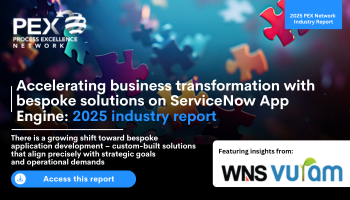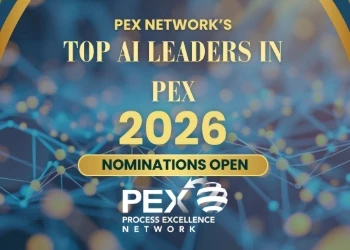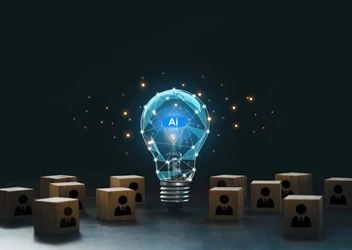WEF & Kaizen Institute: AI fails without streamlined processes
Outdated systems and processes are hampering AI implementation
Add bookmark
The World Economic Forum (WEF) and Kaizen Institute have explored why artificial intelligence (AI) fails without streamlined processes and outlined three strategies for unlocking real value.
In a blog published by the WEF, António Costa, CEO of the Kaizen Institute, claimed that many organizations are “putting the technological cart before the process horse” in the global race to implement AI.
This disconnect explains why, despite massive investments, many AI initiatives fail to deliver meaningful returns. What’s needed is an improvement-first approach that eliminates waste and optimizes processes before applying AI, creating a robust foundation where technology can truly thrive.
Join the PEX Network community

Don't miss any news, updates or insider tips from PEX Network by getting them delivered to your inbox. Sign up to our newsletter and join our community of experts.
Learn MoreOutdated processes hamper AI implementation
Over half of companies say outdated systems and processes are the biggest hurdle to AI implementation, according to a recent Kaizen Institute poll. Despite this, a significant number continue to focus primarily on the technology itself, rather than the underlying operations it will automate.
“The true power of AI emerges when it is integrated into a culture of continuous improvement,” wrote Costa. “Rather than replacing human ingenuity, AI acts as a powerful enabler, enhancing our ability to identify, analyze and act on improvement opportunities. This symbiotic relationship transforms data into actionable insights, leading to significant operational excellence [OPEX].”
Join us at All Access: BPM Business Process Management 2025!
3 steps to successful AI adoption
The most successful companies take a structured path that blends Lean thinking with strategic AI adoption, according to Costa.
1. Laying the foundation: Mapping and optimizing value streams
Before introducing AI, top-performing organizations begin by thoroughly mapping their value streams from end to end. This helps them pinpoint where value is generated and where inefficiencies lie.
For example, a UK-based process industry company, previously focused on capital investments for performance gains, used Value Stream Analysis to examine its complex operations. By identifying and prioritizing key areas for improvement, the company saved £3.2 million (around US$4.1 million) annually, cut planned stoppages by 24 percent and reduced energy use by 24 percent, all without implementing new technology.
“From our experience, value stream mapping creates a shared understanding across departments,” Costa wrote. “When people visualize the entire process together, silos break down and improvement opportunities become obvious.”
2. Integration: Targeted AI implementation
Once processes have been streamlined, organizations are better positioned to strategically introduce AI where it will create maximum value, according to Costa. “The key is starting with focused applications that deliver quick wins rather than attempting organization-wide implementation.”
For example, an automotive supplier can first standardize its maintenance procedures and data collection methods and, by using this clean data foundation, a targeted AI application for predictive maintenance can analyze real-time operational data from equipment sensors.
This approach allows the company to identify potential failures before they lead to unexpected downtimes, significantly improving equipment reliability and ensuring continuous, efficient production.
Beyond predictive maintenance, AI-powered business operations can manifest in various ways:
- Enhanced demand forecasting.
- Optimized quality control.
- Streamlined logistics.
- Personalized customer experiences
“Companies that succeed with AI start small and prove value. They focus on solving specific problems rather than implementing technology for its own sake.”
3. Scaling: AI-enabled learning
After establishing proof points, organizations can expand their AI footprint while maintaining a continuous improvement mindset. “This phase is about scaling what works while building organizational knowledge,” Costa wrote.
For example, a global logistics company implemented digital knowledge-sharing systems that enabled successful AI solutions from one distribution center to be rapidly adapted and rolled out across its entire network. This strategy sped up adoption while allowing local teams to tailor the solutions to their specific operational needs.
Register for All Access: AI in Business Transformation 2025!
Accelerating business transformation with bespoke solutions on ServiceNow App Engine

Today, off-the-shelf software solutions offer diverse features that enable vast opportunities to implement and maintain business transformation. However, in some circumstances, capabilities lack the flexibility and specificity required to address the unique challenges and workflows of individual organizations. As a result, there is a growing shift toward bespoke application development – custom-built solutions that align precisely with strategic goals and operational demands.
Download this report to explore how enterprises can harness the power of custom applications to drive meaningful transformation. With the growing adoption of low-code platforms like ServiceNow App Engine, organizations are building custom applications faster and with greater control. By empowering both IT professionals and citizen developers to build tailored solutions, organizations can significantly reduce time to value while maintaining control over quality and compliance.
Download Now












